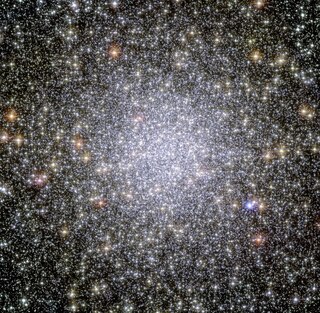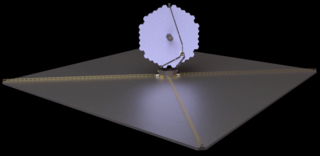
The Chandra X-ray Observatory (CXO), previously known as the Advanced X-ray Astrophysics Facility (AXAF), is a Flagship-class space telescope launched aboard the Space ShuttleColumbia during STS-93 by NASA on July 23, 1999. Chandra was sensitive to X-ray sources 100 times fainter than any previous X-ray telescope, enabled by the high angular resolution of its mirrors. Since the Earth's atmosphere absorbs the vast majority of X-rays, they are not detectable from Earth-based telescopes; therefore space-based telescopes are required to make these observations. Chandra is an Earth satellite in a 64-hour orbit, and its mission is ongoing as of 2024.

XMM-Newton, also known as the High Throughput X-ray Spectroscopy Mission and the X-ray Multi-Mirror Mission, is an X-ray space observatory launched by the European Space Agency in December 1999 on an Ariane 5 rocket. It is the second cornerstone mission of ESA's Horizon 2000 programme. Named after physicist and astronomer Sir Isaac Newton, the spacecraft is tasked with investigating interstellar X-ray sources, performing narrow- and broad-range spectroscopy, and performing the first simultaneous imaging of objects in both X-ray and optical wavelengths.

NASA's series of Great Observatories satellites are four large, powerful space-based astronomical telescopes launched between 1990 and 2003. They were built with different technology to examine specific wavelength/energy regions of the electromagnetic spectrum: gamma rays, X-rays, visible and ultraviolet light, and infrared light.

Messier 28 or M28, also known as NGC 6626, is a globular cluster of stars in the center-west of Sagittarius. It was discovered by French astronomer Charles Messier in 1764. He briefly described it as a "nebula containing no star... round, seen with difficulty in 31⁄2-foot telescope; Diam 2′."

47 Tucanae or 47 Tuc is a globular cluster located in the constellation Tucana. It is about 4.45 ± 0.01 kpc (15,000 ± 33 ly) away from Earth, and 120 light years in diameter. 47 Tuc can be seen with the naked eye, with an apparent magnitude of 4.1. It appears about 44 arcminutes across including its far outreaches. Due to its far southern location, 18° from the south celestial pole, it was not catalogued by European astronomers until the 1750s, when the cluster was first identified by Nicolas-Louis de Lacaille from South Africa.

The Center for Astrophysics | Harvard & Smithsonian (CfA), previously known as the Harvard–Smithsonian Center for Astrophysics, is an astrophysics research institute jointly operated by the Harvard College Observatory and Smithsonian Astrophysical Observatory. Founded in 1973 and headquartered in Cambridge, Massachusetts, United States, the CfA leads a broad program of research in astronomy, astrophysics, Earth and space sciences, as well as science education. The CfA either leads or participates in the development and operations of more than fifteen ground- and space-based astronomical research observatories across the electromagnetic spectrum, including the forthcoming Giant Magellan Telescope (GMT) and the Chandra X-ray Observatory, one of NASA's Great Observatories.
Herbert Gursky was the Superintendent of the Naval Research Laboratory's Space Science Division and Chief Scientist of the E.O. Hulburt Center for Space Research.

The National Aeronautics and Space Administration is an independent agency of the U.S. federal government responsible for the civil space program, aeronautics research, and space research. Established in 1958, it succeeded the National Advisory Committee for Aeronautics (NACA) to give the U.S. space development effort a distinctly civilian orientation, emphasizing peaceful applications in space science. It has since led most American space exploration, including Project Mercury, Project Gemini, the 1968–1972 Apollo Moon landing missions, the Skylab space station, and the Space Shuttle. It currently supports the International Space Station and oversees the development of the Orion spacecraft and the Space Launch System for the crewed lunar Artemis program, the Commercial Crew spacecraft, and the planned Lunar Gateway space station.

Gravity and Extreme Magnetism Small Explorer mission was a NASA space observatory mission. The main scientific goal of GEMS was to be the first mission to systematically measure the polarization of X-ray sources. GEMS would have provided data to help scientists study the shape of spacetime that has been distorted by a spinning black hole's gravity and the structure and effects of the magnetic fields around neutron stars. It was cancelled by NASA in June 2012 for potential cost overruns due to delays in developing the technology and never moved into the development phase.

The 215th meeting of the American Astronomical Society (AAS) took place in Washington, D.C., Jan. 3 to Jan. 7, 2010. It is one of the largest astronomy meetings ever to take place as 3,500 astronomers and researchers were expected to attend and give more than 2,200 scientific presentations. The meeting was actually billed as the "largest Astronomy meeting in the universe". An array of discoveries were announced, along with new views of the universe that we inhabit; such as quiet planets like Earth - where life could develop are probably plentiful, even though an abundance of cosmic hurdles exist - such as experienced by our own planet in the past.

The Astronomy and Astrophysics Decadal Survey is a review of astronomy and astrophysics literature produced approximately every ten years by the National Research Council of the National Academy of Sciences in the United States. The report surveys the current state of the field, identifies research priorities, and makes recommendations for the coming decade. The decadal survey represents the recommendations of the research community to governmental agencies on how to prioritize scientific funding within astronomy and astrophysics. The editing committee is informed by topical panels and subcommittees, dedicated conferences, and direct community input in the form of white papers summarizing the state of the art in each subdiscipline. The most recent report, Astro2020, was released in 2021.
Ann Hornschemeier is an American astronomer specializing in X-ray emission from X-ray binary populations. She is the Chief Scientist for the Physics of the Cosmos program at NASA.

The Large Ultraviolet Optical Infrared Surveyor, commonly known as LUVOIR, is a multi-wavelength space telescope concept being developed by NASA under the leadership of a Science and Technology Definition Team. It is one of four large astrophysics space mission concepts studied in preparation for the National Academy of Sciences 2020 Astronomy and Astrophysics Decadal Survey.

The X-Ray Imaging and Spectroscopy Mission, formerly the X-ray Astronomy Recovery Mission (XARM), is an X-ray space telescope mission of the Japan Aerospace Exploration Agency (JAXA) in partnership with NASA to provide breakthroughs in the study of structure formation of the universe, outflows from galaxy nuclei, and dark matter. As the only international X-ray observatory project of its period, XRISM will function as a next generation space telescope in the X-ray astronomy field, similar to how the James Webb Space Telescope, Fermi Space Telescope, and the Atacama Large Millimeter Array (ALMA) Observatory are placed in their respective fields.

Imaging X-ray Polarimetry Explorer, commonly known as IXPE or SMEX-14, is a space observatory with three identical telescopes designed to measure the polarization of cosmic X-rays of black holes, neutron stars, and pulsars. The observatory, which was launched on 9 December 2021, is an international collaboration between NASA and the Italian Space Agency (ASI). It is part of NASA's Explorers program, which designs low-cost spacecraft to study heliophysics and astrophysics.

Rita M. Sambruna Commander OMRI (Hon) is an Italian-American astrophysicist and is the Deputy Director of the Astrophysics Science Division at National Aeronautics and Space Administration's (NASA) Goddard Space Flight Center. From September 2022 to May 2023, she was the Acting Deputy Director of the Science Exploration Directorate at Goddard. Rita held the Clare Boothe Luce Professorship in Physics and Astronomy at George Mason University in 2000-2005.

Anne L. Kinney is an American space scientist and educator. Kinney is currently the Deputy Center Director at NASA Goddard Space Flight Center. Previously, she held positions as the head of the Directorate for Mathematical and Physical Sciences (MPS) for the National Science Foundation (NSF), the Chief Scientist of the W.M. Keck Observatory, Director of the Solar System Exploration Division at NASA Goddard Space Flight Center, Director of the Origins Program at NASA Jet Propulsion Laboratory, and Director of the Universe Division at NASA Headquarters. She earned a bachelor's degree in astronomy and physics from the University of Wisconsin-Madison and a doctorate in astrophysics from New York University, and has published more than 80 papers on extragalactic astronomy. She was an instrument scientist for the Faint Object Spectrograph that flew on the Hubble Space Telescope.

Jane Rebecca Rigby is an American astrophysicist who works at the Goddard Space Flight Center and is Senior Project Scientist at the James Webb Space Telescope. She was selected one of Nature's 10 Ones to Watch in 2021 and Shape 2022.

Grant Tremblay is an American astrophysicist notable for research on supermassive black holes, science communication, and public advocacy for large space telescopes. He is currently an Astrophysicist at the Harvard-Smithsonian Center for Astrophysics, and was formerly a NASA Einstein Fellow at Yale University, a Fellow at the European Southern Observatory (ESO), and an Astronomer at ESO's Very Large Telescope (VLT).

















